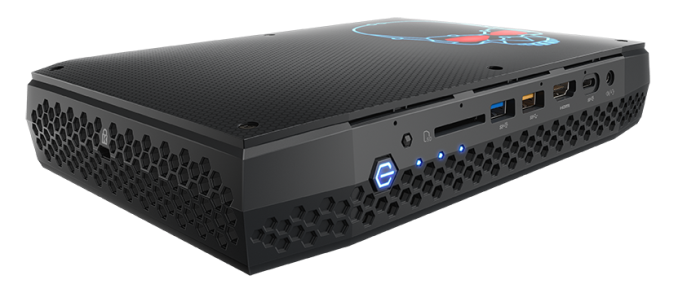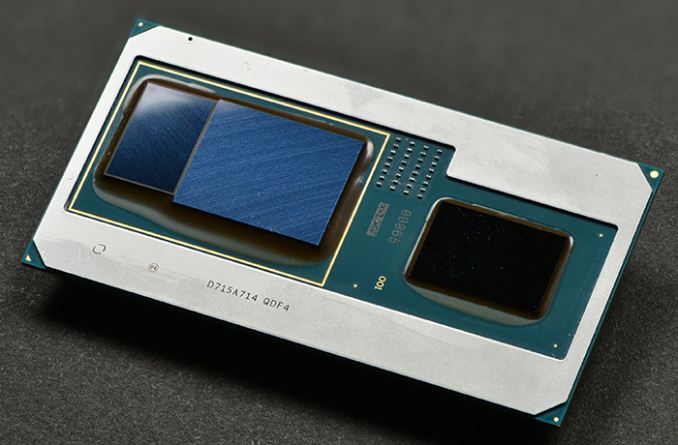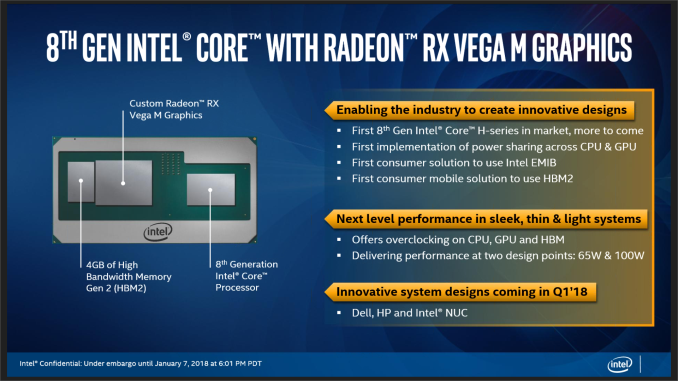Intel Core with Radeon RX Vega M Graphics Launched: HP, Dell, and Intel NUC
by Ian Cutress on January 7, 2018 9:02 PM ESTFinal Words
Does This Make Intel and AMD the Best of Frenemies?
It does seem odd, Intel and AMD working together in a supplier-buyer scenario. Previous interactions between the two have been adversarial at best, or have required calls to lawyers at the worst. So who benefits from this relationship?
AMD: A GPU That Someone Else Sells? Sure, How Many Do You Need?
Some users might point to AMD’s financials as being a reason for this arrangement, in the event that Zen didn’t take off then this was a separate source of income for AMD. Ultimately AMD is looking healthier since Ryzen, and even if Intel did rock up with piles of money, the scope of the product is unclear how much volume Intel would be requesting.
Or some might state that this sort of product, if positioned correctly, would encroach into some of AMD’s markets, such as laptop APUs or laptop GPUs. My response to this is that it actually ends up a win for AMD: Intel is currently aiming at 65W/100W mobile devices, which is a way away from the Ryzen Mobile parts that should come into force during 2018. For every chip they sell to Intel, that’s a sale for them. It means that there discrete-class graphics in a system that might have had an NVIDIA product in it instead. One potential avenue is that NVIDIA’s laptop GPU program is extensive: now with Intel at the helm driving the finished product rather than AMD, there is scope for AMD-based graphics to appear in many more devices than if they went alone. People trust Intel on this, and have done for years: if it is marketed as an Intel product, it’s a win for AMD.
Intel: What Does Intel Get Out Of This?
Intel’s internal graphics, known as ‘Gen’ graphics externally, has been third best behind NVIDIA and AMD for grunt. It had trouble competing against ARM’s Mali in the low power space, and the scaling of the design has not seemed to lend itself to large, 250W GPUs for desktops. If you have been following certain analysts that keep tabs on Intel’s graphics, you might have read the potential woes and missed targets that have potentially happened behind closed doors every time there has been a node shrink. Even though Intel has competed with GT3/4 graphics with eDRAM in the past (known as the Crystalwell products), some of which performed well, they came at additional expense for the OEMs that used them.
So rather than scale Gen graphics out to something bigger, Intel worked with AMD to purchase Radeon Vega. It is unclear if Intel approached NVIDIA to try something similar, as NVIDIA is the bigger company, but AMD has a history of being required by one of Intel’s big OEM partners: Apple. AMD has also had a long term semi-custom silicon strategy in place, while NVIDIA does not advertise that part of their business as such.
What Intel gets is essentially a better version of their old Crystalwell products, albeit at a higher power consumption. The end product, Intel with Radeon RX Vega M Graphics, aim to offer other solutions (namely Intel + NVIDIA MX150/GTX1050) but with reduced board space, allowing for thinner/lighter designs or designs with more battery. A cynic might suggest that either way, it was always going to be an Intel sale, so why bother going to the effort? One of the tracks of Intel’s notebook products in recent years is trying to convince users to upgrade more frequently: for the last couple of years, users who buy 2-in-1s were found to refresh their units quicker than clamshell devices. Intel is trying to do the same thing here with a slightly higher class of product. Whether the investment to create such a product is worth it will bear out in sales numbers.
It's Not Completely Straightforward
One thing is clear though: Intel’s spokespersons that gave us our briefing were trained very specifically to avoid mentioning AMD by name about this product line. Every time I had expected them to say ‘AMD Graphics’ in our pre-briefing, they all said ‘Radeon’. As far as the official line goes, the graphics chip was purchased from ‘Radeon’, not from AMD. I can certainly understand trying to stay on brand message, and avoiding the name from an x86 competitive standpoint, but this product fires a shot across the bow of NVIDIA, not AMD. Call a spade a spade.
Aside from the three devices that will be coming with the new processors, from HP, Dell, and the Intel NUC, one interesting side story came out of this. Intel has already had interest from a cloud gaming company for these new processors. In the same way that a massive GPU based-datacenter can offer many users cloud gaming services, these new chips are set to be in the datacenter for 1080p gaming at super high density, perhaps moreso than current GPU solutions. An interesting thought.

Intel NUC Enthusiast 8: The Hades Canyon Platform
The HP and Dell units are set to be announced later this week during CES. For information about the Intel NUC, using the overclockable Core i7-8809G processor, Ganesh has the details in a separate news post.


















66 Comments
View All Comments
B166ER - Sunday, January 7, 2018 - link
Exaggeration to emphasize a point..tipoo - Monday, January 8, 2018 - link
What's the point if it doesn't remotely make sense? That's not an exaggeration, it's just not the truth, the dGPU is significantly better than any Intel iGPU.Cooe - Monday, January 8, 2018 - link
Umm. Lol can you read? Perhaps you need your eyes checked? Because I really can't fathom how you ended up at THAT conclusion. This is a near GTX 1060 level part we're talking about here (and well beyond the 1050Ti). As others have said, it'll fall right around the MaxQ version of the 1060. That's damn impressive considering the size & power envelope.OEMG - Sunday, January 7, 2018 - link
In page 4 ("Intel’s Performance Numbers") the last table's headers are wrong (should be GH vs 1060).I wonder how FreeSync would work if they're powering down the pGPU. One guess is some sort of mode switching to the iGPU's display engine as for light workloads the iGPU is more than capable to maintain max display frame rate. But then, there's some protocol stuff being done in FreeSync/G-Sync so it could also be that the pGPU's display engine would always be on with the iGPU feeding into it.
neblogai - Sunday, January 7, 2018 - link
On 4th page, last two charts (and also text between them) should have GH series part, instead of i7-8509G Vega M GL.StevoLincolnite - Sunday, January 7, 2018 - link
"Coffee Lake processors, using Intel’s latest 14++ process and running up to 8 cores."I could have sworn they only topped out at 6-cores.
nerd1 - Sunday, January 7, 2018 - link
I don't get it, AMD GPU has never been good for efficiency, but now they claim to beat NVdia 1050/1050 ti in terms of efficiency.... sounds too good to be true.tipoo - Sunday, January 7, 2018 - link
EMIB + HBM2 + a multichip module with Intel is what it takes apparently. With all those edges, I'm sure it can manage to edge out 1050 perf/watt like they say, it's not all in the architecture.tipoo - Sunday, January 7, 2018 - link
Also states power sharing saves 18 watts, so that's a lot of handicaps for the more efficient Pascal to catch up with.Cooe - Monday, January 8, 2018 - link
EMIB adds nothing performance or efficiency-wise over a regular interposer like AMD uses. It's simply thinner/cheaper. Also, people drastically undervalue how power efficient Vega is when clocked in it's efficiency "sweet spot". The reason it looks so bad in Vega 56/64 (the latter especially) is because the clocks have been pushed right up to the process' limits, and well, well beyond said "sweet spot". The clock's being used here, otoh, fall right within it (for obvious reasons). I think people are going to be very surprised by both the efficiency here, and in the Vega Mobile dGPU AMD announced today (which could very well be based off this graphics part, but we'll know soon enough. I'd bet my lunch it ends up in discrete desktop cards as well at some point to replace at-least the 560 & 570, and possibly 580).